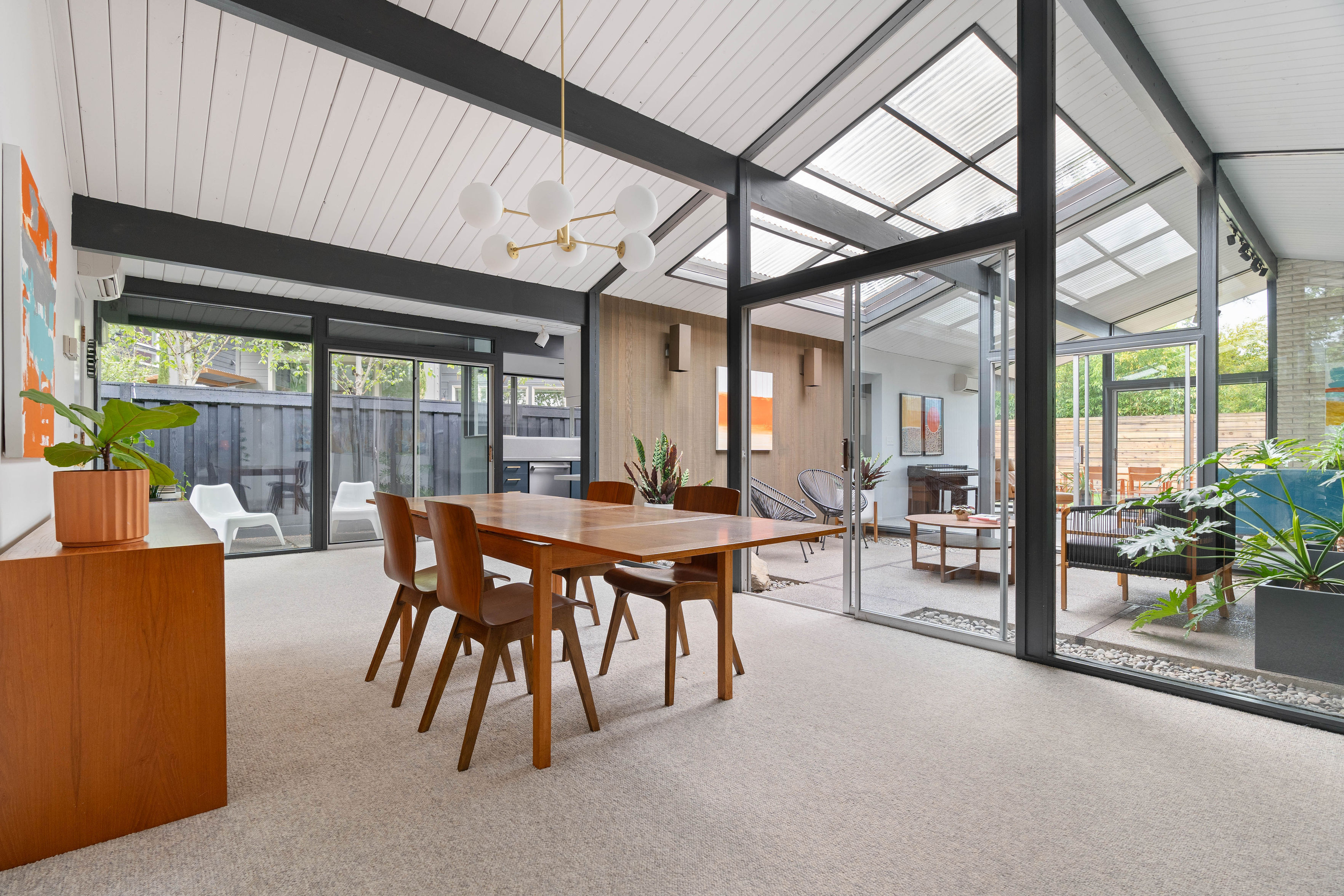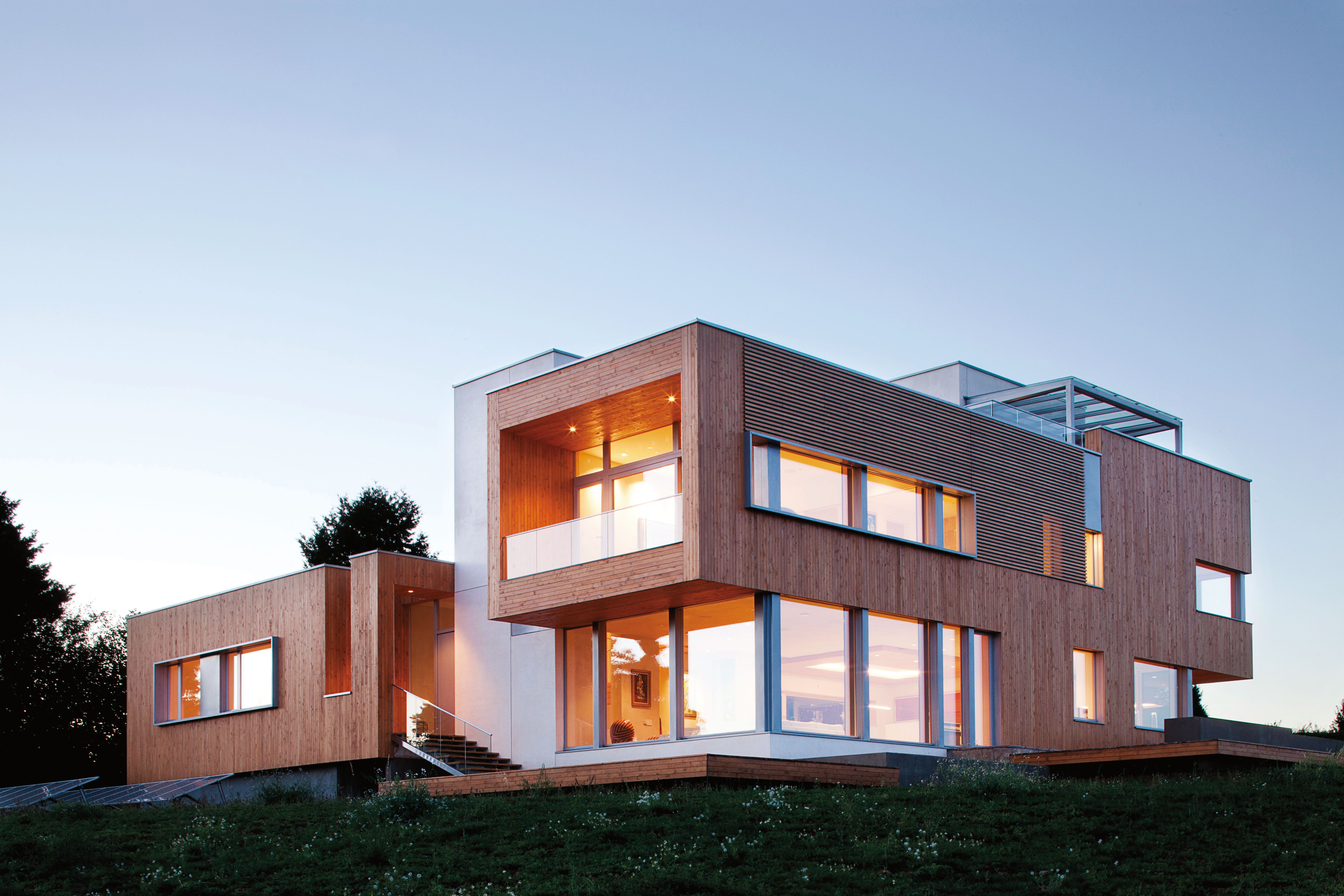
Great New Portland Homes
Karuna House
Holst Architecture // 2013

Image: Courtesy Jeremy Bittermann
When Holst Architecture and builders Hammer & Hand created Karuna, a dreamy outcropping of modernism atop a lush Willamette Valley vineyard, the project was hailed for its green aspirations. Commissioned by philanthropist Eric Lemelson, the house was designed to qualify for three distinct sustainability certifications; for net-zero energy consumption; and to serve as a case study for builders to come.
Three years later, results point to success. According to Holst’s Cory Hawbecker, between April 2015 and April 2016 Karuna produced 13 percent more energy than it consumed, thanks to its 10-kilowatt solar array and the passive-house construction regime’s focus on supertight insulation. “We would do a version of the design, run it through an energy model, revise it, and repeat,” Hawbecker says. “That really affects the details of the design, and the specifics of how you put it together.”
Hawbecker is as proud of Karuna’s look as he is of its energy bill: "Design came first,” he says, "but the aesthetics and sustainability are very closely related." A thick stack of press coverage and awards—a 2014 Green Builder award for best building science, for example—seems to validate Lemelson’s desire to create a model others could follow. “Personally, what I learned on this project gets applied to every other project, whether it’s residential or not,” Hawbecker says.
Is it a good house? “Eric kind of raves about how comfortable it is,” the architect adds. “He does kind of have to open the windows to hear the birds sing, though.” —ZD
Five Square
Lever Architecture // 2015

Image: Courtesy Jeremy Bittermann
Quick, think “classic Portland house.” Did you picture a foursquare?
“They’re almost the default vision of what a Portland home is supposed to look like,” observes architect . “They’ve become what people aspire to.”
The imposing, dignified boxes from the late 19th or early 20th century line many east-side streets, their generous pillared porches serving as standing advertisements for a fantasy lifestyle of neighborly conviviality and Adirondack chair lounging. The only thing is, foursquares are kind of boring: they can mass into ranks of sameness, and, inside, their antiquated layouts can feel like dark warrens.
When Robinson—not boring, himself, with a résumé that includes stints at marquee modernist firms Herzog & de Meuron in Switzerland and Allied Works in Portland—set out to reboot a typical Southeast Portland foursquare, his big move was to break the genre’s iconic chunk. A shard-like geometric growth protrudes from the top of the house now known as Five Square, dark walls and body-tall windows gallivanting at a cocked angle to the house’s old-time rectitude. That skewed angle affords views of Mount Tabor, but the clients weren’t just interested in the view; Robinson tailored the study-like room inside to suit their love of family movie nights.
The overall effect is cinematic, to be sure. Robinson also used the design’s rooftop coup de théâtre to open up the interiors. A modernized layout rich in natural light now orients toward the backyard. “We were interested in creating as strong a connection to the back as to the front, which is not typical for a foursquare,” Robinson says. —ZD
Newberg Residence
Cutler Anderson Architects // 2013
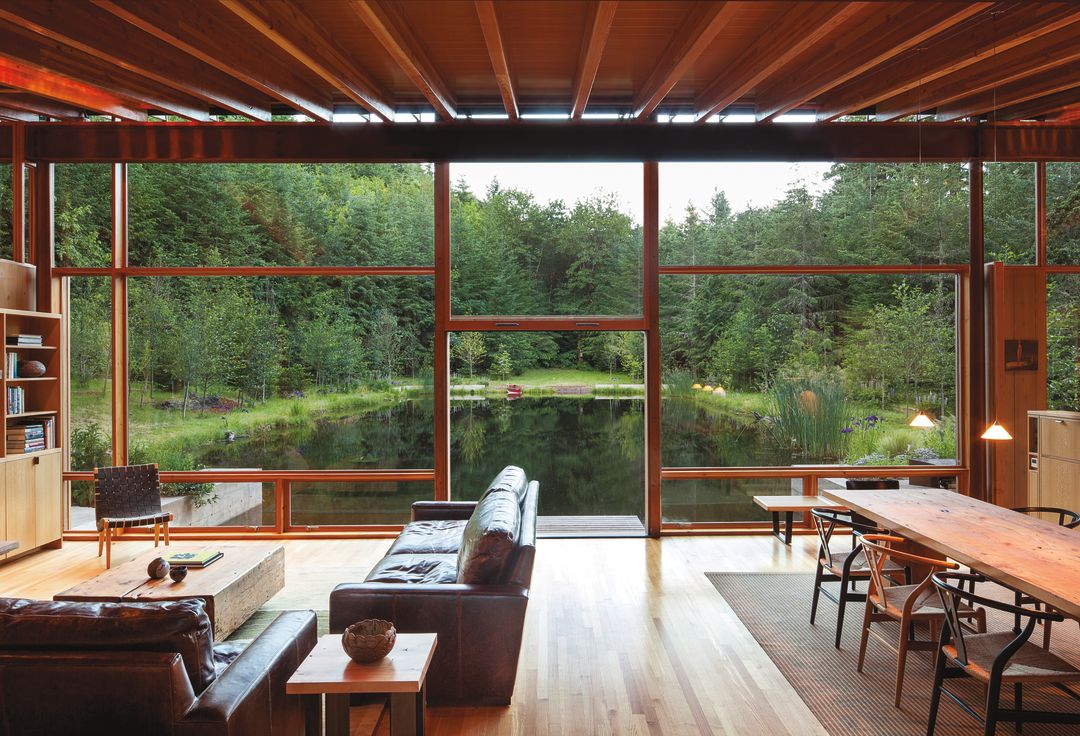
Image: Courtesy Jeremy Bittermann
“All the work we do, 100 percent of it, is engaged in tangible reality,” architect James Cutler says of his Bainbridge Island, Washington-based firm. “We look at what is true and real about a place and try to amplify that experience.”
Even when that means trading a hilltop for an old logging pond. A few years ago, Cutler was examining a potential job in the Willamette Valley’s wine country, for a client who’d already chosen a commanding view from the top of the property. But the site just didn’t appeal to Cutler, whose firm’s residential practice is a gallery of elegant, calming additions to landscapes from Napa Valley to Mallorca. “It had nice views,” he recalls, “but it would have been really hard to navigate with vehicles.”
On the way down, he saw a glimmer of light through a stand of trees and found what was left of an old man-made pond.
“I thought we could do something really nice,” he says.
Cutler Anderson got the job, a rare instance of landing a design gig by rejecting a clients’ original premise. What emerged is part home (a neatly cut slab of wood and glass, with a living space that opens onto a dive-ready deck), part environmental revitalization. The structure won a 2016 American Institute of Architects award for excellence in housing design. And there are subtler rewards. “We sat out on the deck for dinner one evening,” Cutler recounts, “and the owner said, ‘OK, the cedar waxwings will be here in 10 minutes. And 10 minutes later, there they were. Then the robins. Then the bats.”
Sounds like a tangible reality, amplified. —ZD
Red House
Waechter Architecture // 2015
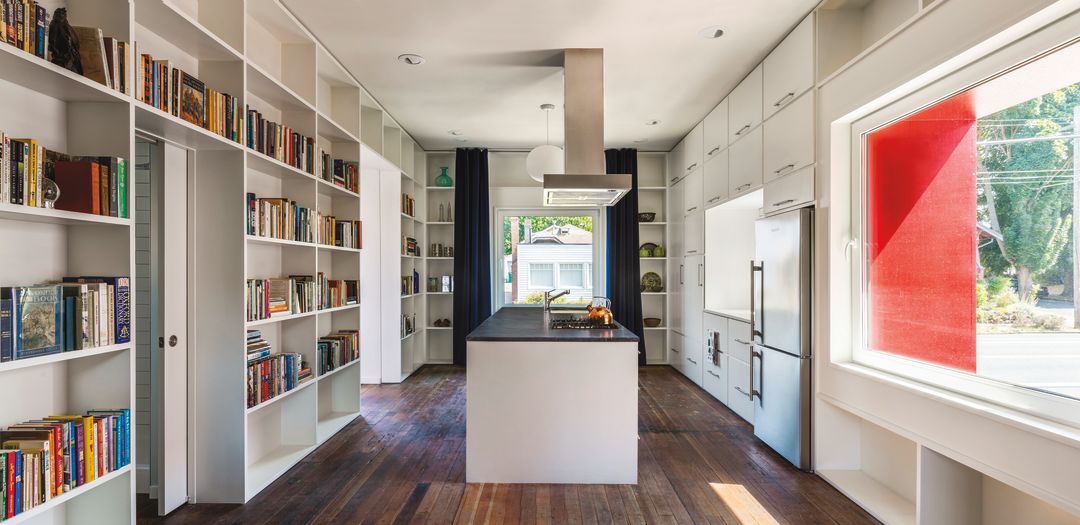
Image: Courtesy David Papazian
In the beginning, it was Quiet House. With clients who love their lively Southeast Portland neighborhood but hate (seriously: hate) noise, architect Ben Waechter set out to turn a circa-1905 Queen Anne's cottage-style residence into an oasis of tranquility.
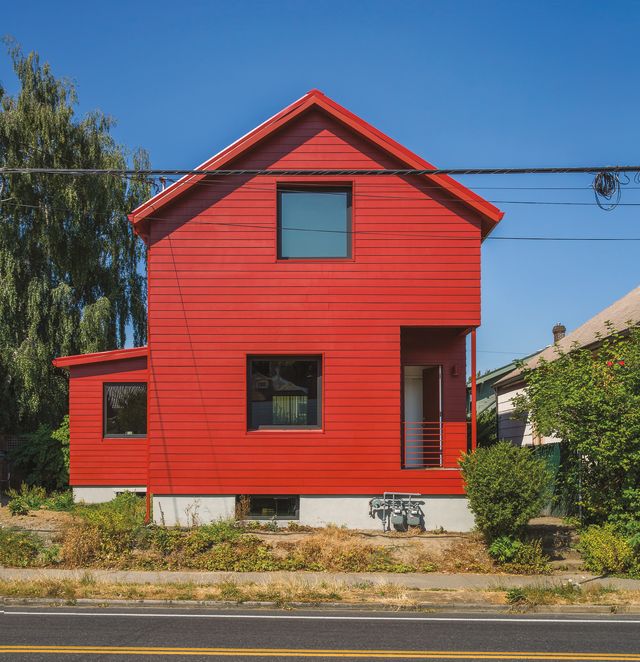
Image: Courtesy David Papazian
The interiors came down to the studs, the internal room configuration changing to a series of what the architect calls doughnut-shaped spaces, swaddled in a vast array of bookshelves. (“They’ve never, ever had enough space for all their books,” Waechter notes of his clients. “We gave them almost too much.”) The house-wide library has natural sound-insulating qualities, but that was just the start. Each window is recessed between one and two feet and armored with triple-glazed glass. Spray-foam insulation, acoustic metal, and special acoustic drywall contributed to the cocoon.
Then came the exterior. Waechter decided to leave the basic form of the house unchanged. “But we wanted to render that form in a really modern, almost abstract way,” the architect says. “They wanted something bold, and we said, ‘If that’s what you want, let’s go for it.’” And so he opted for the solid, monolithic red of a Monopoly hotel. “It has a sort of 3-D sculptural quality,” Waechter says.
In the end, it became Red House. —ZD
Hayashi Townhomes
Hacker Architecture // 2015
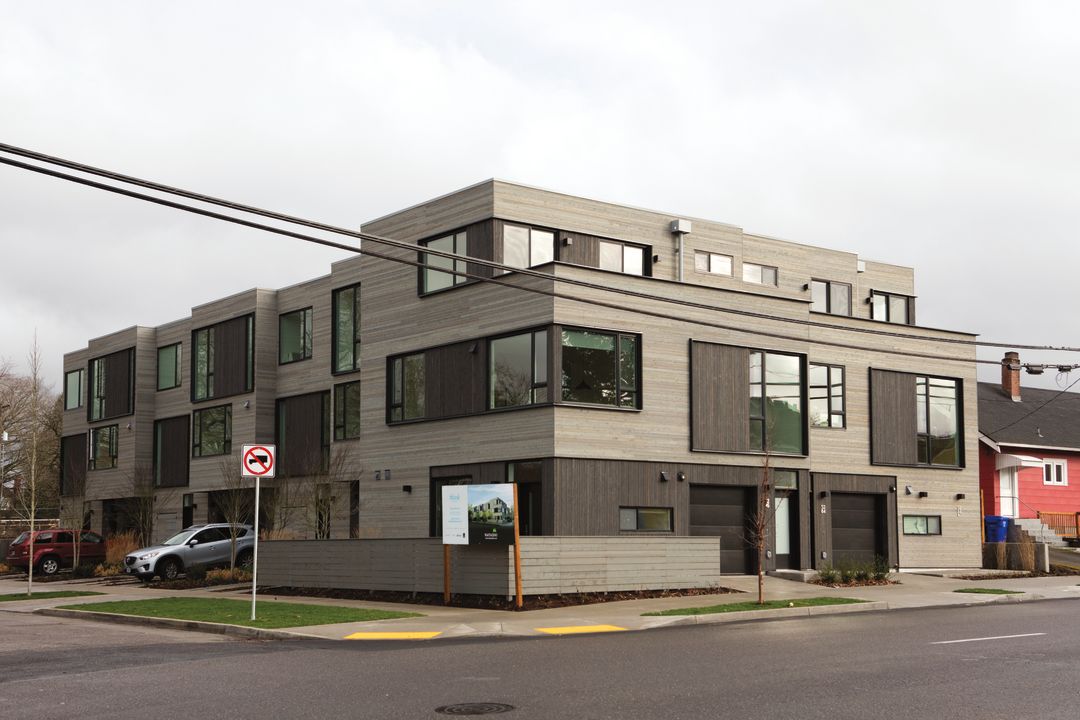
Image: Courtesy Shawn Records
In the fast-changing corridor defined by North Williams and Vancouver Avenues, size tends to reign: multistory, mixed-use buildings dominate recent redevelopment, sometimes with hulking results. But the lot at Vancouver and Emerson, destined to become a nest of town houses called Hayashi (“woods,” in Japanese), isn’t zoned for the bulky projects in the corridor’s nearby commercial area. Clad in muted cedar, it can embody a gentler brand of urbanity.
To weave its eight units together on a compact lot and forge connections to natural light and the outdoors for each, designer Corey Martin of architecture firm Hacker created three different floor plans. (“Sometimes it was like, seriously? We’re doing three?”) Each accesses either a terrace or a small yard; two include small accessory dwelling units. Martin’s plans express distinct personalities, some looking out into the neighborhood to capture an urban vibe, others focused on their garden spaces and tranquility. Some units feature double-height ceilings to maximize their use of natural light; Martin tucked Hayashi’s skylights along walls to give subtlety to just how that light pours in.
“It’s definitely high density,” Martin says of the project, which sold out quickly. “But it’s a buffer zone between the real high density you’re seeing in the commercial district there and the neighborhood that surrounds it. It’s urban, but it’s still single-family housing.” —ZD
Canterbury Residence
Scott Edwards Architecture // 2016
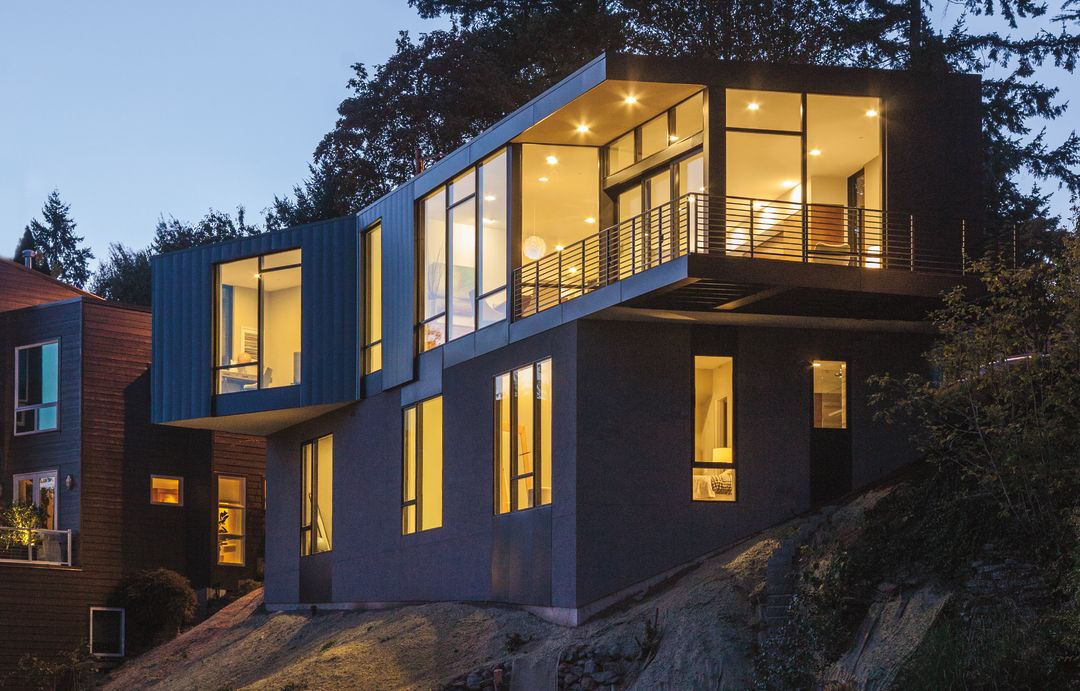
Image: Courtesy Pete Eckert
The Canterbury Castle was dead. What would reclaim its lofty throne?
Yes, once a castle—a noble basalt-clad keep, monument to 1920s whimsy, or perhaps folly—stood on a precipitous West Hills lot, with sweeping views to suit its delusions of chivalric grandeur. It fell to dereliction and, in 2009, to the wrecking ball. Owners and builders contemplated the abdicated realm’s forbidding grade, and the landslides that stalk it.
“We’ve done lots of steep lots,” says architect Peter Grimm of the firm Scott Edwards. “This one looked particularly menacing.”
At last, owners Rob and Kristen Reichenbach teamed with Grimm to conquer the challenges, which also included a view easement forbidding construction on two-thirds of the lot. “It was like a Venn diagram,” Grimm says. “We could only build in the little spot where all the conditions converged—a little wedge-shaped piece of land.”
Fortunately, the Reichenbachs and Grimm found themselves of one aesthetic mind, uniting upon a “crisp, simple box,” as the architect puts it, “a quiet design.” The house’s public spaces would be on the upper level, with bedrooms down below—all atop a foundation system Grimm likens to that beneath a downtown high-rise. The construction team from iBuildPDX drove 25 concrete piers, each two feet in diameter, 25 to 30 feet deep.
“It sits pretty lightly on the site visually,” Grimm says. “But it’s anchored deep.”
As construction wrapped up last year, a new twist arose: the Reichenbachs moved to the Bay Area, summoned by the siren call of a job at Apple. At press time, the house is unoccupied and for sale, listed at about $1.8 million.
Says Grimm: “I feel like there are chapters yet to be written.” —ZD
Phoenix House
Hinge Build // 2016
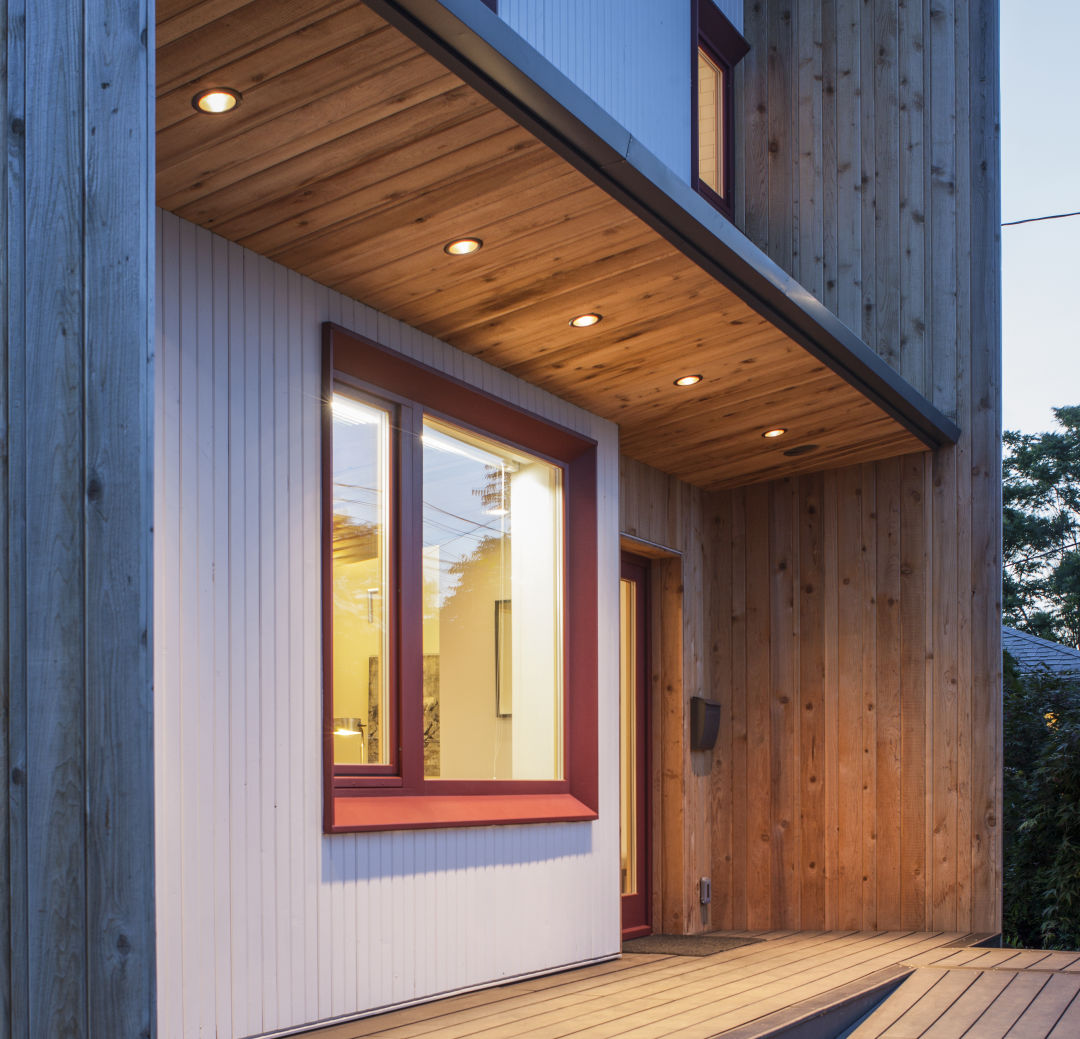
When architect Scott Kosmecki decided to replace the Northeast Portland house he’d owned for 17 years, he opted to recycle a few things. First, the foundation. “The footprint makes a nice ratio of green space for a standard lot,” he says. "Why not keep it?" He also kept the old house’s fir sheathing and red oak floors: material sourced about as locally as you can get. And then there was the pitched-roof form. “Ask a kid to draw a house,” says Kosmecki, “and they’ll draw a gable-end.”
Everything else in the newly completed project Kosmecki has dubbed “Phoenix” (as in, rising) is new, and, for Portland, exotic: a super-energy-efficient “passive house.” Using techniques pioneered in Germany around 1990, the Phoenix features walls 16 inches thick with insulation and a limited number of windows, all triple-glazed. The heat? A tiny Mitsubishi heat pump and, as a supplement, one Cadet wall heater. Much of the warmth comes from conserving heat from the refrigerator motor, computers, the dryer, and occupants’ body heat. Northern Europeans have built tens of thousands of passive houses. Portland currently has eight.
Twice as tall as the old house, Phoenix faces the street with a stylishly deep, 18-inch bevel, as Kosmecki describes it, “to express the super-insulated walls’ thickness.” Official rules from the Passive House Institute US limit window square footage for energy efficiency, so Kosmecki uses windows strategically, pushing most to the corners to better bounce light, and placing an LED on top of them, “so that night light would feel like daylight.” The upstairs bathroom features a high, interior glass clerestory to welcome in extra sun from the stairwell’s single skylight.
Sure, he tore down an old house for a larger, more expensive new one. But Kosmecki, a passive house evangelist, argues the replacement is not just better, it’s ethical. “If you’re not building Passivhaus,” he says, using the German term for the concept, “you’re stealing land. It’s what we should be building.” He also nods to Portland's likely future earthquake. “When the power goes out, people can still live in it.” —RG
Doppelgänger
Works Partnership // 2016
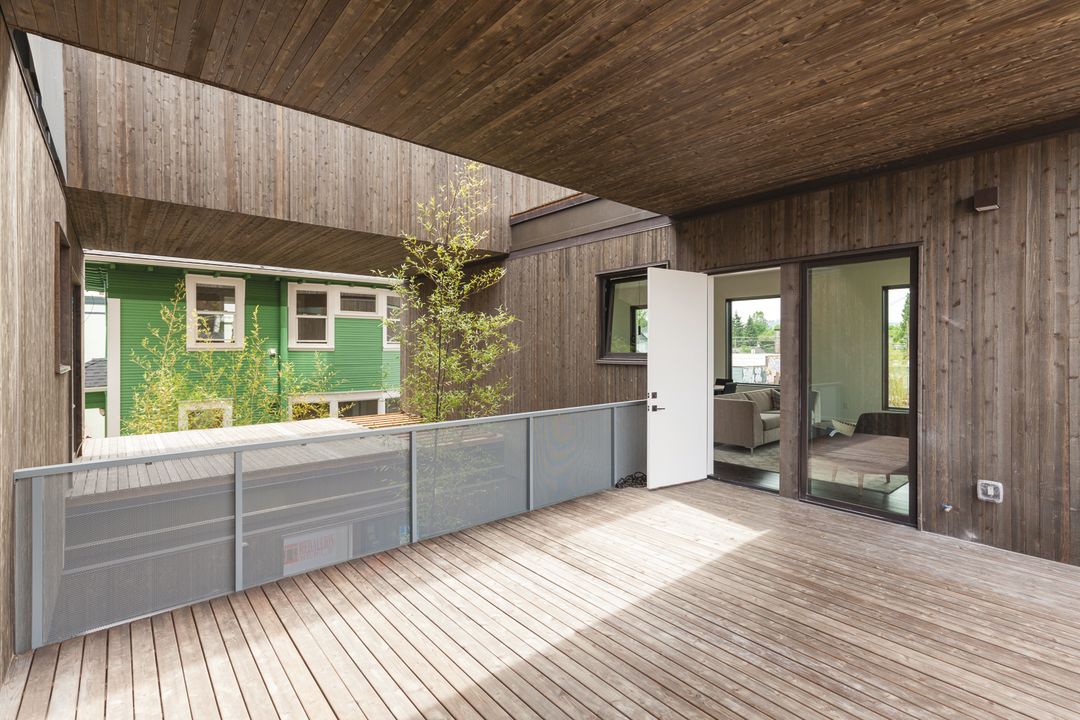
Image: Courtesy Joshua Jay Elliott
William Neburka and Carrie Strickland like boxes. Their prolific high-design, boutique architecture firm, Works Partnership, uses the form like shipping containers ready to stack—only clad in elegant steel siding and large panes of glass. One of their earliest big buildings, the B-Side6 on East Burnside, suggests a Jenga game, cantilevered forms seemingly begging to slide apart. Nearby, their soon-to-be finished Block 75 resembles a smooth kindling stack of shiny Johnny Walker Black boxes, white beveled ends exposed.
“It’s a way to conceptualize mass,” says Neburka, who keeps a box of wooden blocks in his office. “How do you break a building into parts?”
Works’s new duplex, the Doppelgänger, is arguably their most architecturally pure version of the theme. It is, quite literally, six boxes stacked around a central courtyard. Each 2,500-square-foot home is made up of three identical volumes. But rather than setting the boxes simply atop each other, Strickland and Neburka interwove them. Each units’ floors are joined by stairs climbing up, around, and over. Garages are on the bottom; the kitchen/living room volumes span across the garages; bed/bath sections bridge the other way. Each unit has decks on its upper two levels, atop the roof of its neighbors. Hinting at his own astonishment, Neburka says: “It actually came together.”
Indeed, the interior spaces are generous and graceful. Works used some of the largest windows commercially available: 8 feet square. Developer-contractor Ryan Zygar of Tieton Homes anted up extra cash to wrap every exposed surface in cedar to maximize the clarity of the forms—one unit’s volumes are rough sawn; the other, smooth.
For builders, city examiners, and the bank, the plans were as confusing as an M.C. Escher drawing. “It cost more to build it,” Zygar acknowledges—to be exact, 45 percent more than a similarly well-built duplex, mostly due to the extra exterior surfaces and windows. “But you get to enjoy what you bought. Every room has natural light at both ends. You can’t get that in a duplex.” —RG
359
Kaiser Group & Path Architecture // 2016
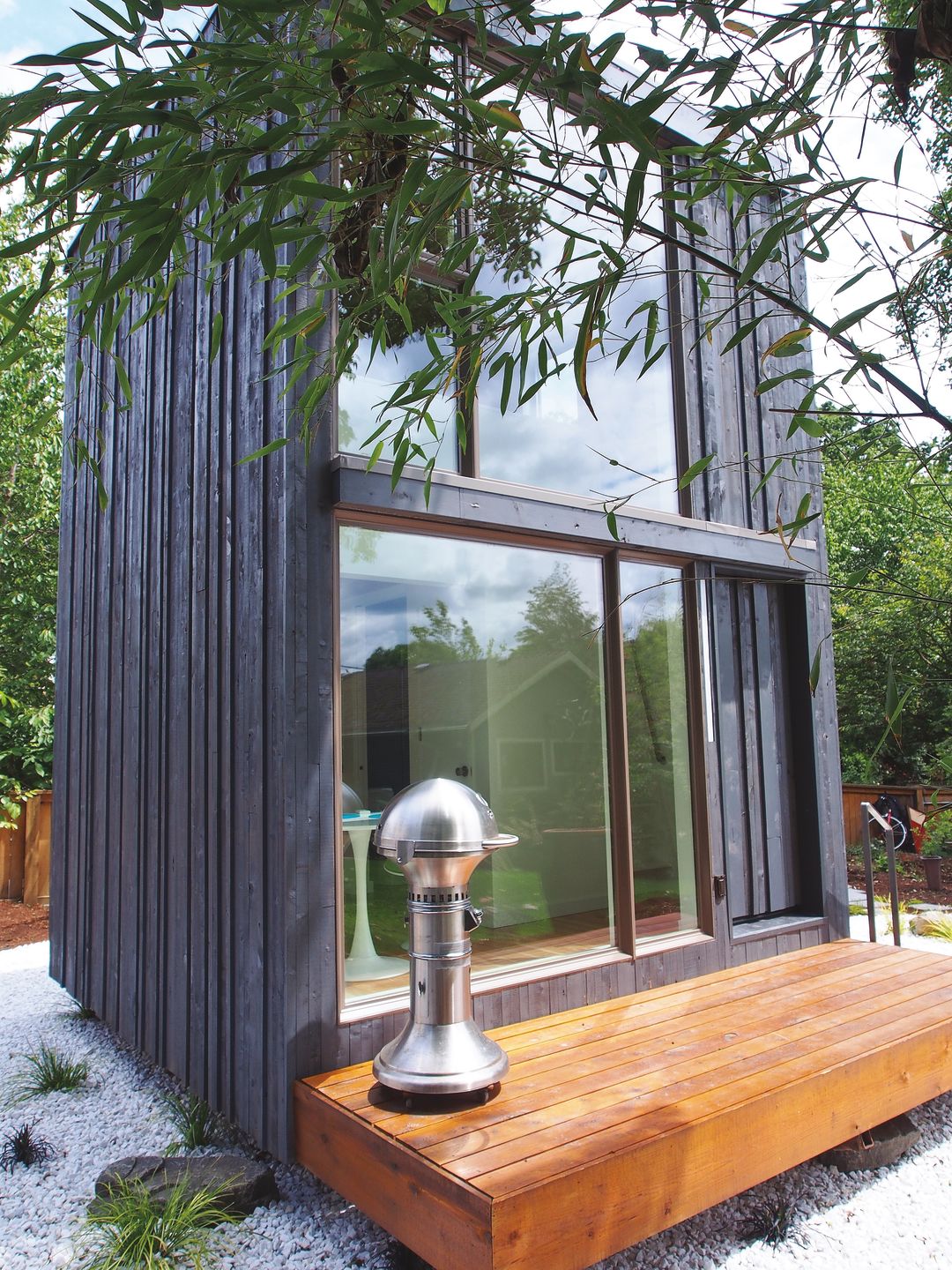
Image: Courtesy Evan Stravers
Educated as an architect, Ben Kaiser came of age as a builder. The longtime local developer has repurposed old tilt-up warehouses into elegant commercial condominiums and lofts, built North Williams’s first new office building, and recently broke ground on a project, Carbon12, that figures to be the nation's tallest cross-laminated timber building when it's done.
But he was born a tinkerer. During the Great Recession, Kaiser’s then-idle hands went to work on a new kind of tiny house—one that rotated. His simple idea: be able to orient a house to, or away from, the sun. Kaiser got some steel wheels and had a friend fabricate a track, a steel bezel, and clips to hold it in place. He poured a concrete footing in his backyard. Working with mechanical engineers, he further developed his experiment: he envisioned a 12-by-12-foot structure, framed in steel, two floors high, super-insulated, topped by solar panels, and equipped with a self-composting toilet. “It could exist in balance by itself,” he dreamed. “You could lift it in place with a crane, and hook it up to a garden hose.” The projected cost: $84,000.
But then a city regulator, passing on his bike, “busted” Kaiser; the footprint he’d created was bigger than what the city allows, sans building permits, for a standard shed. Kaiser shelved the idea until his friends Ethan Caughy and Becca Kennedy invited him to build it on their second lot. The result is not quite the maverick house Kaiser dreamed. The couple liked the spin, but not the composting toilet. And thus the compromises began: sewer, water, electrical hookups. It rotates in either direction, but, alas, only 359 degrees. Kaiser found solutions, like a four-inch rotating couplet made for the natural gas industry that allowed the house’s sewer connection to twist leak-free. Except for that final 1 degree, the house works as planned, turning enough to catch the winter sun in two generous sides of windows, or turning its back—among other reasons, to give the well-daylit bedroom loft some privacy. Using a six-foot steel pole that inserts into a bracket, even the couple's two preteen kids can rotate the house.
Kaiser has had inquiries for the plans from Ireland, Japan, and the Czech Republic. “They all think it’s going to be $45,000,” he chortles. (The final price, with city permits, he says, was $150,000.) Kaiser also continues to look for opportunities for his pure, off-grid version—the 360 House. He’s thinking about the Oregon coast, where being self-sufficient might be a good idea someday. “My dream,” he says, “is to lift nine of these off the truck onto the same property, and have them all rotating around.” —RG
Kerns Microhouse
Fieldwork Architecture // 2016
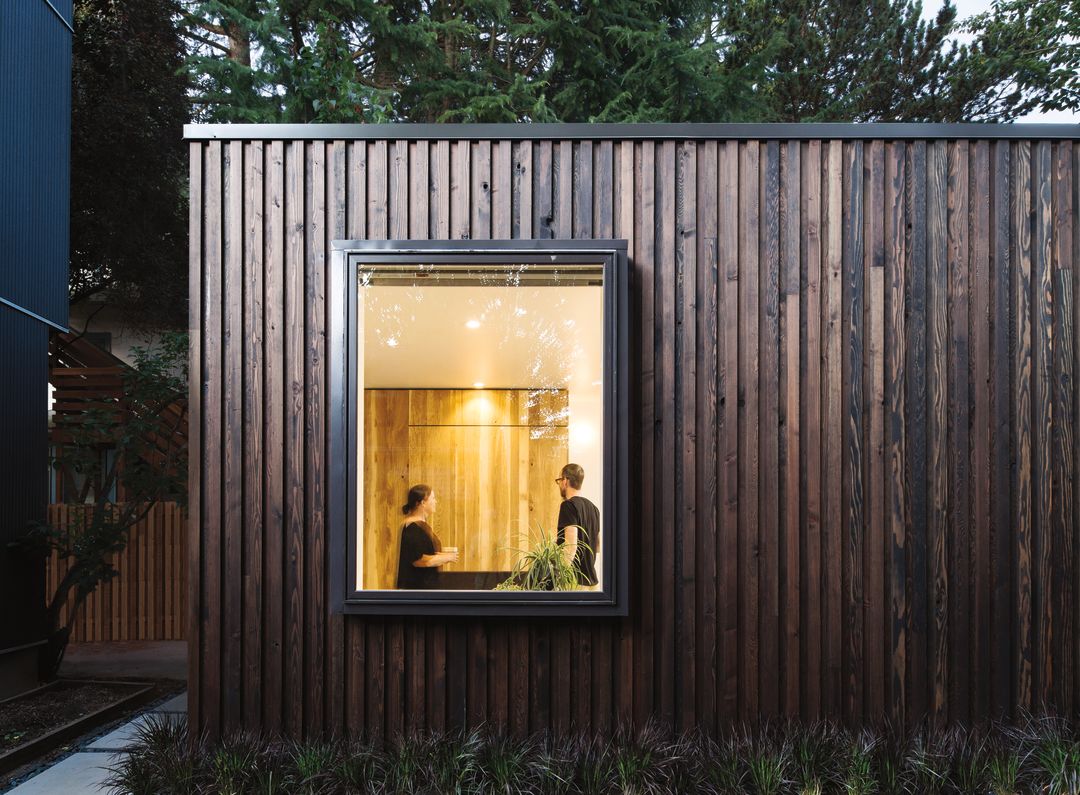
Image: Courtesy Dana Klein
If you wanted to script a comedy of manners set in the current world of Portland residential design, you could call it Much Ado About ADUs. Everyone wants a little backyard pod for visiting in-laws, cute and cosmopolitan imaginary Airbnb guests, or just themselves, when it’s time to chillax in the legendary cone of silence.
But even as these microcottages proliferate, few manage to be interesting. (City regulations on accessory dwelling units guard against both ugliness and beauty, sharply limiting what ADUs can look like on the outside.) An honorable exception: Fieldwork Design’s handcrafted, 250-square-foot hutch in an inner Northeast backyard. The firm pared down details to create a pleasingly minimalist cube, then focused on fine-grained details like interior casework, flooring, and materials. Oregon white oak lends an elegant simplicity to the inside. The poured concrete floor flows smoothly into the tiny bathroom’s shower, with no curb to clutter up the compact space. Outside, the dark-stained board-and-batten fir siding (A-OK by the city!) adds visual heft.
“We thought of this as a piece of furniture,” says Fieldwork’s Tim Fouch. “Too much detail started to feel extraneous fast. We considered flexibility and ease of maintenance. A small building could feel really cheap and underthought. I think we avoided that.”
Fouch’s clients plans for the little place? Originally, it was to be a literal mother-in-law lodging. Now? Airbnb and, as Fouch puts it, “an escape hatch.”
And so the plot unfolds. —ZD



